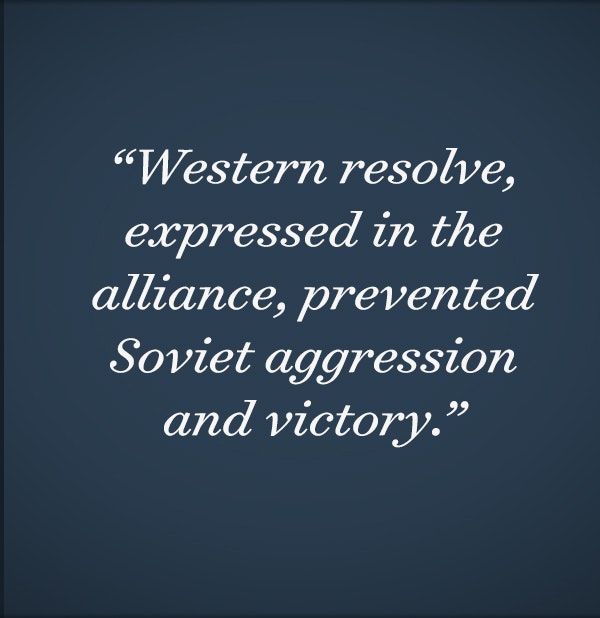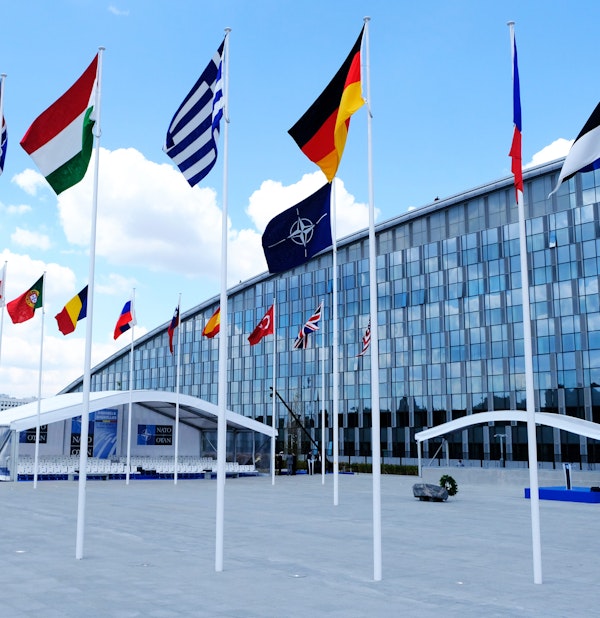NATO: Still Relevant in a Dangerous World
A look back at NATO’s history reveals that the alliance accomplished the objectives it was created to address. And in a new era, NATO can once again prove important to global security.
 Heads of governments of member countries at the 2018 NATO Summit. (Alexandros Michailidis / Shutterstock)
Heads of governments of member countries at the 2018 NATO Summit. (Alexandros Michailidis / Shutterstock)
This year, the North Atlantic Treaty Organization marks its 70th anniversary. In the world of international statecraft, such long-lasting alliances are exceedingly rare. NATO’s longevity is due in part to the fact that it combines national interest, which can be fleeting, with national values, which are hopefully more lasting.
The initial alliance between the United States, Canada, and 10 European nations founded in 1949 has grown to encompass 29 countries. Once ratified by all current members, North Macedonia will join as NATO’s 30th member.
Some, though, most notably the president of the United States, have questioned whether NATO membership is still in the U.S. national interest. While the White House avers that the U.S. commitment to NATO remains solid, even the perception of a breach between Europe and America would foster Russia’s longstanding desire to rupture the alliance.
The Trump administration’s concern over burden sharing is by no means a new issue – it has been an off-and-on irritant over much of the alliance’s history. In the 1970s, Europe was spending approximately 45 percent of what the United States was spending on defense. The Center for Transatlantic Relations notes that three factors combined to address the disparity: Moscow was becoming more belligerent, America was preoccupied in a longstanding conflict in Vietnam, and Europe was enjoying a period of relative prosperity. By the end of the Cold War, Europe was spending approximately 78 percent of U.S. levels.
Today’s situation is somewhat analogous: Moscow is becoming more belligerent, America is engaged in a 17-year war in Afghanistan (side-by-side with our NATO allies), and Europe is enjoying relative prosperity. And European defense spending is beginning to rise. As Daniel Fried, the assistant secretary of state for Europe from 2005 to 2009, put it, “By all means, America should push for greater allied defense spending. But today (and everyday) let’s also remember — and respect — the sacrifice that others have made for us.”
Why NATO was created
The values that bind the alliance have remained constant, but NATO has not been static. In fact, its durability is linked to its flexibility – changing and modernizing as threats have grown and receded. It’s important to recognize that NATO succeeded in its core historical mission – deterring an aggressive rival and keeping the West strong and free.
It’s important to recognize that NATO succeeded in its core historical mission – deterring an aggressive rival and keeping the West strong and free.
Established in the first phase of the Cold War, NATO was one response to the vacuum created after World War I, when America sought to disengage from Europe’s power struggles and conflicts. In contrast to the Senate’s refusal to approve the treaty establishing the League of Nations, America sought after World War II to fashion a new and lasting international architecture. That included the United Nations, the World Bank, the International Monetary Fund, the General Agreement on Tariffs and Trade (the forerunner of the World Trade Organization), and a host of security agreements and alliances, most notably NATO.
 President Harry S. Truman signs the North Atlantic Treaty on August 29, 1949, marking the beginning of NATO. (MPI/Getty Images)
President Harry S. Truman signs the North Atlantic Treaty on August 29, 1949, marking the beginning of NATO. (MPI/Getty Images)
Beginning with President Harry S. Truman and continuing through the Cold War, presidents and Congresses of both parties embraced this American-made architecture that helped the United States realize historic prosperity, saw freedom expand across the globe, and prevented a devastating nuclear war with an aggressive and expansionist Soviet Union.
While regional conflicts were frequent and often bloody, the theory of mutually assured destruction (MAD) contained the 50-year standoff between the United States and the Soviet Union. The uneasy peace was costly and often tense – the Cuban Missile Crisis, conflict in the Middle East, Vietnam – but a cataclysmic third world war was avoided. Western resolve, expressed in the alliance, prevented Soviet aggression and victory.
The reduced tensions of détente largely fell apart after the Soviet invasion of Afghanistan in 1979, awakening Americans and Europeans alike to the fact that the Soviets still posed an existential threat. The decision to deploy a new class of missiles in Europe spawned the nuclear freeze movement and severely strained the alliance. But the fact that NATO held together was a key moment in the Soviet Union’s defeat.
Western resolve placed unsustainable pressure on the Soviets and their allies. The system collapsed in the 1980s and 1990s, as a new Soviet leader found it impossible to compete. The rise of the independent labor union Solidarity in Poland led to free elections, as Soviet leader Mikhail Gorbachev refused to intervene. The fall of the Berlin Wall and a series of mostly bloodless revolutions rolled out across Central and Eastern Europe. And long suppressed nationalism within the Soviet Union – in Lithuania, Ukraine, and elsewhere – led to the dissolution of the USSR itself on December 26, 1991.

The map of Europe was remade. Fifteen states emerged from the wreckage of the Soviet Union. Most of them, including Russia, sought a democratic and free market future. Many declared their ambition to join the European Union and NATO. Over the next two decades, 13 post-communist nations took their rightful places as full members of the North Atlantic Alliance.
But the question arose – what was the purpose of NATO when its main foe was no longer a threat (or even existed)?
After the Cold War
Since the fall of the Soviet Union and its Warsaw Pact allies, NATO has reinvented itself. The alliance built to face down the Soviets has taken on new challenges and missions, proving it remains the most important U.S. alliance.
NATO’s current mission was laid out in 2010. The alliance remains a mutual defense pact – each member commits to defend the others against attack, including against “new threats to the safety of our citizens.”
It also maps out the importance of conflict management – preventing and managing conflicts and stabilizing post-conflict situations. NATO is committed to working with partners around the globe, to working toward a world without nuclear weapons, and to allow European democracies that meet the standards for membership to join the alliance.

One of the first major tests for the post-Soviet NATO occurred after Yugoslavia’s dissolution. NATO took the leading role in ending the fighting and bringing stability to Bosnia and Herzegovina. From 1999 on, NATO has played a similar role in Kosovo. Ending the bloodshed was a key U.S. political priority during the Clinton administration. While the United States could have addressed these crises alone, our NATO partners worked with us and carried some of the load.
After the terrorist attacks of September 11, 2001, NATO’s Article V was activated for the first and only time in the alliance’s history. Article V of the NATO Treaty commits each member to defend the others when under attack. For America’s NATO partners, the attacks on Washington and New York were just the same as an attack on Rome, Berlin, Toronto, or Oslo.
After the terrorist attacks of September 11, 2001, NATO’s Article V was activated for the first and only time in the alliance’s history. … For America’s NATO partners, the attacks on Washington and New York were just the same as an attack on Rome, Berlin, Toronto, or Oslo.
Invoking Article V was more than just a rhetorical expression of solidarity – our NATO allies, along with other partners like Australia, have fought with the United States in Afghanistan. More than 1,000 soldiers from NATO partners have been killed.
While you may disagree on the merits of American involvement in Bosnia, Kosovo, or Afghanistan – they were national security priorities of the U.S. government. In each conflict, America’s NATO partners took up arms in American-led engagements. Having allied support lessened the burden and furthered the security priorities of the United States.
Sadly, the original rationale for NATO has returned in new, insidious ways. The Russian experiment with democracy that begin in the late 1980s has been all but extinguished. Vladimir Putin’s Russia has moved away from liberalism and democracy toward a state now best characterized by authoritarianism, crony capitalism, and corruption. Most importantly, Putin has acted aggressively to restore power and land lost when the Soviet Empire imploded.
 In 2014, Russia annexed Crimea, on the south of Ukraine.
In 2014, Russia annexed Crimea, on the south of Ukraine.
Moscow has sought to encourage separatist movements in several former Soviet republics. In 2014, Russia stepped up its longstanding military interference in Ukraine by annexing Crimea. And in Central and Eastern Europe, Russia has pursued aggressive policies, aimed at restoring its influence. Countries across the region have faced new kinds of threats, as Moscow works to manipulate and discredit democratic institutions.
Moscow has also sought to silence critics and boost its influence in longstanding democracies. In 2006, former intelligence agent Alexander Litvinenko was assassinated in the United Kingdom. Cyberattacks have been detected in Canada, France, Germany, the Netherlands, the UK, and elsewhere. And in the United States, Russia undertook an unprecedented campaign to stoke divisions and influence the 2016 election campaign.
While the immediate threat of military conflict between Russia and the United States is low, Russia and other states pose a serious and changing threat to America and its allies. NATO is an essential first line of defense.
While the immediate threat of military conflict between Russia and the United States is low, Russia and other states pose a serious and changing threat to America and its allies. NATO is an essential first line of defense.
An alliance and a community of values
NATO’s mission remains first as a military alliance, but from the earliest days, it was also a community of values. And while at times NATO has chosen to look the other way, promoting democracy among its members has always been a consideration.
Article 10 of the NATO Charter states that by unanimous agreement, any other European state that can further the principles of the alliance and contribute to its security may be asked to join. Greece and Turkey joined the alliance in 1952, even though both countries underwent long periods of military rule. Even today, with rising concerns about democratic backsliding in countries like Hungary and Turkey, both countries remain active members of the alliance.
But NATO’s commitment to values became much more explicit as the former communist nations began jockeying for inclusion. Would-be members must demonstrate they are market economies and stable democracies based on a respect for human rights and the rule of law. Aspirants must live in peace with their neighbors, peacefully resolving disputes. And joining NATO requires civilian and democratic control over the military.
Meeting today’s challenges
 NATO Headquarters in Brussels, Belgium. (Shutterstock)
NATO Headquarters in Brussels, Belgium. (Shutterstock)
Seventy years on, NATO remains a vital partnership and resource for the United States. It has contributed blood and treasure to the two most recent major conflicts – Iraq and Afghanistan. It has adapted in response to the new threats emanating from Moscow, shoring up defenses in the Baltic region, partnering with states in Russia’s crosshairs like Ukraine and Georgia, and providing important communications and coordination to defend against the ongoing cyberwarfare.
NATO’s critics are not wrong to urge increased defense spending across the alliance. Most American presidents have done so and our NATO allies are responding to the call. But the United States as a global power will always shoulder a greater share of the burden.
As this history shows, we should look at NATO not as a drain on our resources, but rather as a net plus. America and its NATO allies have faced tensions and estrangement over policy issues. But even when tensions have been high, leaders on both sides of the Atlantic have always recognized that the alliance is mutually beneficial.
Fundamentally, NATO has endured because it is a community of shared values – of democracy, freedom, market economics, solidarity, and mutual respect. The United States and our partners share a strong interest in preserving this partnership – it has worked to our common benefit for 70 years and continues to do so today.
Seventy years on, NATO continues to be a vital partnership and resource for the United States.
-
Previous Article Why America Must Answer Freedom's Call An Essay by Nicole Bibbins Sedaca, Fellow in the Human Freedom Initiative at the George W. Bush Institute
-
Next Article Facing the Economic Challenge from China An Essay by Matthew Rooney, Managing Director of the Bush Institute-SMU Economic Growth Initiative, and J.H. Cullum Clark, Director of the Bush Institute-SMU Economic Growth Initiative

